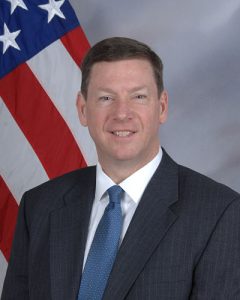This blog post is an excerpt from GovLoop’s upcoming e-book, “The Foundation for DoD Innovation.” Download the full e-book here once it is out.
The Defense Logistics Agency (DLA) manages the global supply chain for the entire U.S. military. Operating in most states and 28 countries, DLA needs a reliable IT network to handle information about the roughly $37 billion goods and services it provides annually.

Dempsey Hackett, the director of DLA’s enterprise infrastructure services.
Few know this better than Dempsey Hackett, the director of DLA’s Enterprise Infrastructure Services. Hackett leads DLA’s team of 600 IT infrastructure personnel, and he’s also responsible for the agency’s network telecommunications.
During an interview with GovLoop, Hackett explained how far DLA’s network must reach to keep its operations running smoothly worldwide. Hackett also shared what other agencies can learn from DLA’s network modernization moves.
This interview was lightly edited for length and clarity.
GOVLOOP: How does enterprise visibility into DLA’s networks help U.S. citizens and warfighters?
HACKETT: The largest benefit directly supports our warfighter customers by providing them with consolidating reporting that addresses all their interactions with our agency.
For example, a few years ago, we went through a significant modernization effort associated with our [enterprise resource planning] (ERP) solution to add in energy commodities. These commodities were being managed through legacy systems, but to provide our service customers with complete reporting, we added in fuels, electricity and natural gas into the solution.
Another benefit is auditability. We’re able to provide single reports to an auditor. In turn, they give taxpayers some reassurances that we’re being good stewards of the resources provided to DLA.
There are additionally some benefits associated with data standardization. It’s our ability to have more streamlined and effective processes by minimizing the number of legacy systems and moving as many as we can into a smaller number of enterprisewide systems.
What obstacles is legacy IT creating for DLA’s mission of delivering logistical support to warfighters?
A lot of legacy IT is expensive to operate, can pose cybersecurity risks and can hinder innovation. It’s an area that DLA has aggressively tacked through our application rationalization project.
In 2013, we had about 1,308 distinct DLA applications. Through that project, we’ve driven that number down to about 194 applications. We realize that number is still very large, and we’re continuing to try driving it as low as possible.
Another problem with these legacy IT systems is many were hosted in our on-premise data centers. By having more applications in those, you get all the other requirements associated with them. It’s things like making sure that the heating, ventilation and air conditioning (HVAC) systems and the uninterruptable power supplies and monitoring are up and running. It’s not really DLA’s core business.
What are some best practices for modernizing networks that you would recommend to other agencies?
It all starts with having buy-in from a senior leader. We’ve been fortunate here at DLA. Our former and current CIOs had that vision of where they wanted to take the organization and what capabilities that they wanted to provide. They took that vision and then they shared it with other senior leaders to gain buy-in.
We also can’t forget our end users and their representatives. We want to make sure that we have a lot of strategic communications which cater to the change management process. We realized that you must do this through multiple venues because not everyone reads those helpful IT emails. We reinforced those messages with town halls, and at some of our various sites tech councils, which are composed of IT-savvy end users. You educate them about the things that are coming up, including the benefits and the capabilities.
It’s additionally important to make sure that we keep our union representation up to speed on the changes and impacts to the workforce. It’s key to make sure that our users understand the changes that we’re making, and so we try to communicate about them in the greatest number of venues.
Finally, sometimes there’s a balance between speed and ease of use with cybersecurity. There are times when you must make those tradeoffs. That’s another area where we just need to make sure that we’re communicating with our users so that they fully understand the entire picture from all aspects. It includes their interactions with the system and the larger cybersecurity picture.
How do DLA’s IT personnel help the rest of your agency’s operations and workers using its networks?
Within our IT organization, we consider ourselves enablers for DLA’s overall logistics mission. The whole reason we’re here is to support our agency, who can then in turn support the warfighter.
We have a ‘whole of government’ mission. For example, we support the Federal Emergency Management Agency [FEMA] in times of natural disasters. We have both DLA folks and even an IT contingency team that can deploy and set up communications in areas that have been devastated by various events.
DLA’s director routinely reminds us that we have a global mission. We have folks in our agency across the entire world, and we’ve got IT folks out there supporting them to make sure that they can support our nation’s only combat support logistics agency.





Leave a Reply
You must be logged in to post a comment.